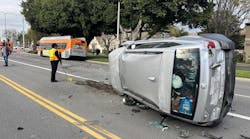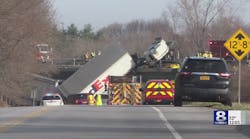Subject: Airbag Supplemental Restraint Systems
Topic: Airbag Inflators Under Vehicle Fire Conditions
Objective: Understand how airbag supplemental restraint system inflator units react under vehicle fire conditions
Task: Given a vehicle that has been involved in a fire, responders will inspect the airbag restraint systems and determine how they reacted during the vehicle fire.
There is a lot of information provided from many different fire service sources on the topic of airbag supplemental restraint systems (SRS) when exposed to vehicle fire conditions. I have personally experienced several incidents where airbag inflator units exploded during a vehicle fire and flew out of the burning vehicle. Every vehicle fire instructor cautions responders about the hazards that deploying airbags, exploding airbag inflators, and flying shrapnel can present during a car fire.
Early airbag inflators used solid chemical propellants to deploy the airbag. This is still a common inflator design for the driver’s frontal airbag, but as technology has progressed, stored gas inflators have become the most common airbag inflator design for the front passenger airbag, knee bags, as well as seat and roof airbags.
Sealed inflator canisters typically contain pressurized gas in the 6,000 to 8,000 psi range. There is no relief valve or ”blow-out” port built into these inflators. The inflators may deploy their airbag as designed when they are overheated in a fire. This would actually be a ”best-case” situation for firefighters. When overheated, the sidewall of the inflator may rupture, creating a hole in the steel canister that may harmlessly release the pressurized gas. In a worst-case scenario, the inflator can reach its failure point and violently fail, sending shrapnel flying in any and all directions.
The hazards that firefighters are exposed to at a vehicle fire related to these airbag inflator units are real. This University of Extrication article presents a simple training checklist that responders can use the next time they have a burnt vehicle available for inspection. The average number of airbags in a typical late-model vehicle today is six, although currently there are 27 possible airbag inflator locations to look for when conducting this training exercise.
For each airbag present in the burnt vehicle being studied, determine where the airbag inflator is located, what type of inflator is present (chemical or stored gas), and what happened to the inflator unit during the vehicle fire. Examples are shown to guide you through this process.
“Airbags in Fire” Training Checklist
- Driver Frontal Airbag
- Passenger Frontal Airbag
- Front Knee Airbags (Driver/Passenger)
- Side Impact Seat-mounted Airbags (Front Seat/Rear Seat/Cushion)
- Roof-mounted Airbags (Side/Rear Window)
- Door-mounted Airbags
- Inflatable Rear Seatbelt Restraint System Airbags
- Additional Systems: Pretensioners, Rollover Protection
Read Part 2 here.






